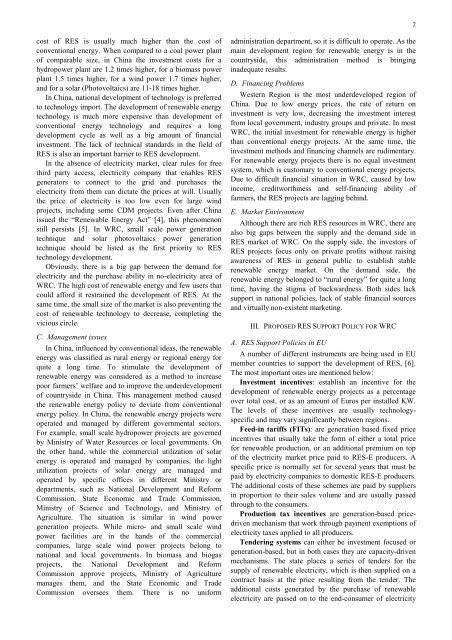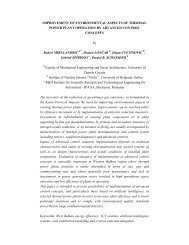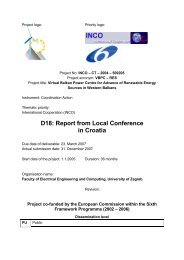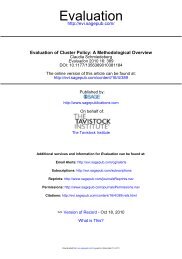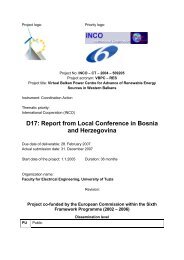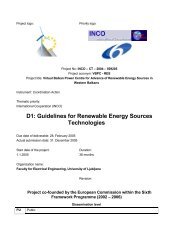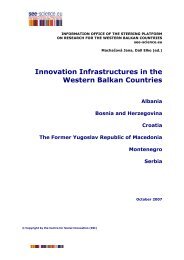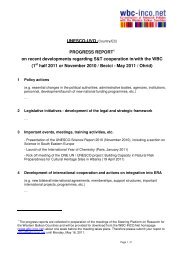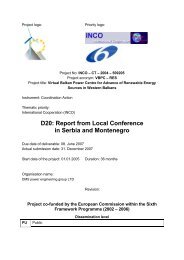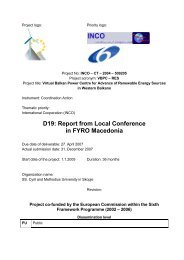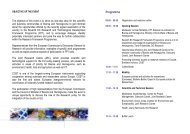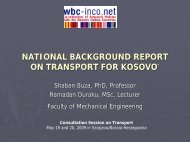Prva stran - WBC-INCO Net
Prva stran - WBC-INCO Net
Prva stran - WBC-INCO Net
You also want an ePaper? Increase the reach of your titles
YUMPU automatically turns print PDFs into web optimized ePapers that Google loves.
cost of RES is usually much higher than the cost of<br />
conventional energy. When compared to a coal power plant<br />
of comparable size, in China the investment costs for a<br />
hydropower plant are 1.2 times higher, for a biomass power<br />
plant 1.5 times higher, for a wind power 1.7 times higher,<br />
and for a solar (Photovoltaics) are 11-18 times higher.<br />
In China, national development of technology is preferred<br />
to technology import. The development of renewable energy<br />
technology is much more expensive than development of<br />
conventional energy technology and requires a long<br />
development cycle as well as a big amount of financial<br />
investment. The lack of technical standards in the field of<br />
RES is also an important barrier to RES development.<br />
In the absence of electricity market, clear rules for free<br />
third party access, electricity company that enables RES<br />
generators to connect to the grid and purchases the<br />
electricity from them can dictate the prices at will. Usually<br />
the price of electricity is too low even for large wind<br />
projects, including some CDM projects. Even after China<br />
issued the “Renewable Energy Act” [4], this phenomenon<br />
still persists [5]. In WRC, small scale power generation<br />
technique and solar photovoltaics power generation<br />
technique should be listed as the first priority to RES<br />
technology development.<br />
Obviously, there is a big gap between the demand for<br />
electricity and the purchase ability in no-electricity area of<br />
WRC. The high cost of renewable energy and few users that<br />
could afford it restrained the development of RES. At the<br />
same time, the small size of the market is also preventing the<br />
cost of renewable technology to decrease, completing the<br />
vicious circle.<br />
C. Management issues<br />
In China, influenced by conventional ideas, the renewable<br />
energy was classified as rural energy or regional energy for<br />
quite a long time. To stimulate the development of<br />
renewable energy was considered as a method to increase<br />
poor farmers’ welfare and to improve the underdevelopment<br />
of countryside in China. This management method caused<br />
the renewable energy policy to deviate from conventional<br />
energy policy. In China, the renewable energy projects were<br />
operated and managed by different governmental sectors.<br />
For example, small scale hydropower projects are governed<br />
by Ministry of Water Resources or local governments. On<br />
the other hand, while the commercial utilization of solar<br />
energy is operated and managed by companies, the light<br />
utilization projects of solar energy are managed and<br />
operated by specific offices in different Ministry or<br />
departments, such as National Development and Reform<br />
Commission, State Economic and Trade Commission,<br />
Ministry of Science and Technology, and Ministry of<br />
Agriculture. The situation is similar in wind power<br />
generation projects. While micro- and small scale wind<br />
power facilities are in the hands of the commercial<br />
companies, large scale wind power projects belong to<br />
national and local governments. In biomass and biogas<br />
projects, the National Development and Reform<br />
Commission approve projects, Ministry of Agriculture<br />
manages them, and the State Economic and Trade<br />
Commission oversees them. There is no uniform<br />
administration department, so it is difficult to operate. As the<br />
main development region for renewable energy is in the<br />
countryside, this administration method is bringing<br />
inadequate results.<br />
D. Financing Problems<br />
Western Region is the most underdeveloped region of<br />
China. Due to low energy prices, the rate of return on<br />
investment is very low, decreasing the investment interest<br />
from local government, industry groups and private. In most<br />
WRC, the initial investment for renewable energy is higher<br />
than conventional energy projects. At the same time, the<br />
investment methods and financing channels are rudimentary.<br />
For renewable energy projects there is no equal investment<br />
system, which is customary to conventional energy projects.<br />
Due to difficult financial situation in WRC, caused by low<br />
income, creditworthiness and self-financing ability of<br />
farmers, the RES projects are lagging behind.<br />
E. Market Environment<br />
Although there are rich RES resources in WRC, there are<br />
also big gaps between the supply and the demand side in<br />
RES market of WRC. On the supply side, the investors of<br />
RES projects focus only on private profits without raising<br />
awareness of RES in general public to establish stable<br />
renewable energy market. On the demand side, the<br />
renewable energy belonged to “rural energy” for quite a long<br />
time, having the stigma of backwardness. Both sides lack<br />
support in national policies, lack of stable financial sources<br />
and virtually non-existent marketing.<br />
III. PROPOSED RES SUPPORT POLICY FOR WRC<br />
A. RES Support Policies in EU<br />
A number of different instruments are being used in EU<br />
member countries to support the development of RES, [6].<br />
The most important ones are mentioned below:<br />
Investment incentives: establish an incentive for the<br />
development of renewable energy projects as a percentage<br />
over total cost, or as an amount of Euros per installed KW.<br />
The levels of these incentives are usually technologyspecific<br />
and may vary significantly between regions.<br />
Feed-in tariffs (FITs): are generation based fixed price<br />
incentives that usually take the form of either a total price<br />
for renewable production, or an additional premium on top<br />
of the electricity market price paid to RES-E producers. A<br />
specific price is normally set for several years that must be<br />
paid by electricity companies to domestic RES-E producers.<br />
The additional costs of these schemes are paid by suppliers<br />
in proportion to their sales volume and are usually passed<br />
through to the consumers.<br />
Production tax incentives are generation-based pricedriven<br />
mechanism that work through payment exemptions of<br />
electricity taxes applied to all producers.<br />
Tendering systems can either be investment focused or<br />
generation-based, but in both cases they are capacity-driven<br />
mechanisms. The state places a series of tenders for the<br />
supply of renewable electricity, which is then supplied on a<br />
contract basis at the price resulting from the tender. The<br />
additional costs generated by the purchase of renewable<br />
electricity are passed on to the end-consumer of electricity<br />
2


